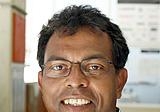Fighters of the future
UNSW engineering researchers are going up against the world's best in a US$1.6 million contest to develop the next generation of military robots.
UNSW engineering researchers are going up against the world's best in a US$1.6 million contest to develop the next generation of military robots.

A team of UNSW engineering researchers has made the semi-finals of a US$1.6 million international robotics competition established to develop the next generation of military robots.
The Multi-Autonomous Ground Robotics International Challenge 2010 (MAGIC 2010) is the first of its kind in the world. Sponsored by the Australian and US defence departments, it aims to further the development of fully autonomous robots for military, commercial and civilian applications.
UNSW team leader, Associate Professor Jay Katupitya of the School of Mechanical and Manufacturing Engineering, said there is enormous interest in self-guiding robots.
"This is a high-level, intensive research and engineering project," Associate Professor Katupitiya said.
"Interest in autonomous ground vehicles is absolutely massive. The military have all kinds of airborne drones and aerial vehicle capabilities but they don't have ground vehicles with the same level of ability."
The UNSW robotic team will be assessed by a panel of military observers during a demonstration this month. If successful the team will cement a place among the top five finalists and receive US$50,000 to further develop their entry for the finals, to be held in South Australia in November.
In the finals, machines will be tested in three scenarios covering indoor and outdoor terrain and various levels of hostile activity.
"Our job will be to map the entire area, map all the bad guys and demonstrate the neutralisation procedure that has to be done," said Associate Professor Katupitiya.
The first, second and third-placed teams will win US$700,000, US$250,000 and US$100,000 respectively and a chance to work with the US and Australian defence forces to develop the robotic soldiers of the future.
By work experience student Ewan Hardeman
UNSW Media Office: Peter Trute | 02 9385 1933 | p.trute@unsw.edu.au